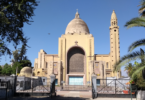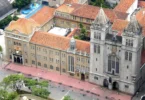
Introduction
The Basilica of Notre-Dame d’Orcival is an Auvergne Romanesque style church located in Orcival in the French department of Puy-de-Dôme in the Auvergne-Rhône-Alpes region.
It is one of the five Romanesque churches of Auvergne called “major”, with the basilica of Notre-Dame-du-Port in Clermont-Ferrand, the church of Saint-Austremoine in Issoire, the church of Saint-Nectaire and the Church of Our Lady of Saint-Saturnin.
Orcival is one of the oldest and most famous Marian shrines in the Auvergne. People have been going there on pilgrimage since before the 10th century. It has a miraculous spring and everything a Black Madonna calls for, except that she was restored to her original pale colors in 1960.
History of Basilica of Our Lady of Orcival, Auvergne

The Church of Our Lady of Orcival was built between 1146 and 1178. In the 11th century, a church located to the east of the village housed an extremely venerated statue of the Virgin; a legend claimed that it had been sculpted by Saint Luke. Everything suggests that the current basilica was built because of the growing success of a pilgrimage. Notre-Dame d’Orcival then became the new home of the famous statue, preserved today in the sanctuary of the church and which has since been the object of an annual pilgrimage, on Ascension Thursday.
The basilica was badly damaged by the strong earthquakes which shook the region in 1477 and 1490. It has been classified as a historical monument since 1840: it is part of the first list of French historical monuments, the list of historical monuments of 1840, which included 1,034 monuments. It is a place of gypsy pilgrimage.
The Black Madonna returned to her place of apparition three times, but eventually she had to content herself with a compromise. The ruins of the original church were called “Tomb of the Virgin”. A monument was built there and every year since the 12th century, on August 15th, the feast of the Assumption of the Blessed Virgin into heaven, Our Lady is carried in a great candle light procession by barefoot men to her “tomb” and then brought back to the village.
Until 1885, she was kept in the crypt, the traditional place for Black Madonnas. Now she resides in a place in the church that is illumined by be sun at noon on August 15th – not bad either!

Exterior Architecture
The Notre-Dame d’Orcival basilica has a remarkable Auvergne Romanesque chevet consisting of a layering of volumes of increasing height:
- Two apsidioles attached to the arms of the transept
- Four radiating chapels
- The ambulatory
- The choir
- The arms of the transept
- The “massif barlong”
- The octagonal bell tower
Its chevet is therefore in all respects comparable to that of the Notre-Dame-du-Port basilica and more developed than that of the church of Saint-Nectaire (which has only three radiating chapels) or that of the church Notre-Dame de Saint-Saturnin (which has none). Among the five Romanesque churches of Auvergne called “major”, only the Saint-Austremoine church in Issoire does better, because it has a rectangular axial chapel.
The characteristic silhouette and the vertical momentum of the Auvergne Romanesque chevets are due to the “massif barlong”, this transversely elongated parallelepiped which surmounts the crossing of the transept and is crowned by the bell tower. The gradual elevation of the volumes is further accentuated by the two lean-to roofs 4 of the “massif barlong”, which frame the birth of the bell tower.

Exterior Decoration
The apse has a polychrome decoration in opus reticulatum (which resembles that of the Carolingian portal of the Abbey of Lorsch). This decoration is however much more sober than that found at the apse of the Saint-Austremoine church in Issoire: there is no mosaic (opus sectile) of polychrome rosettes under the cornice of the choir.
The choir, the ambulatory and the radiating chapels each have a largely overhanging cornice supported by modillions with chips. The windows of the choir are surmounted by polychrome mosaics of lozenges made with trachyandesite and alternate with rectangular boxes each housing three small columns.
The arches of the windows of the ambulatory and the chapels are lined with a cord of billets. The “barlong massif”, meanwhile, is adorned with numerous windows with polychrome keystones.

Lateral Facades
The structure of the side facades of the nave is in all respects similar to what can be observed at the Notre-Dame-du-Port basilica, at the Saint-Austremoine church in Issoire as well as at the church of Saint-Nectaire: the windows of the side facades of the nave, lined with a cord of billets, are housed under large stiffening arches 5 surmounted by triplets of blind bays.

Interior Architecture
The interior is not polychrome as in Issoire, but it has the same structure as in the other major Romanesque churches of Basse-Auvergne.
The Choir
The Choir, vaulted in the bottom of an oven, is surrounded by eight columns crowned with capitals sculpted with plant motifs supporting raised arches surmounted by a second series of openings, alternately openwork and blind.
The Crypt
The Crypt of the basilica is semi-subterranean; it is thus naturally lit by a few stained glass windows.
Our Lady of Orcival

Orcival (French pronunciation: [ɔʁsival]; Auvergnat: Orsivau) is a commune in the Puy-de-Dôme department in Auvergne in central France. The 12th-13th century basilica of Notre Dame is a listed monument. It contains many ancient religious objects, including a 12th century procession statue of the Virgin and Child.
The story here dates back to the 12th Century, when a statue of the Virgin Mary holding the Child Jesus was discovered. It is said that it was carved by Saint Luke.
Upon discovery of the statue, the villagers decided to build a chapel her to house the statue. Work was begun, but the next day the workmen were shocked to find that the walls had been torn down.
This happened more than once some suspecting rivalry from another village. Finally, in anger, one of the workmen threw his hammer into the air and it landed about 300 feet away. It was decided that this is where the Blessed Mother wanted the chapel built, and after that the walls remained.
The Basilica and the statue escaped the ravages of the French Revolution, probably because of the somewhat remote location.

Feast Day - 15th August
Annual Feast Day of Our Lady of Orcival held on 15th August.
Church Visiting Time
Every days
Contact Info
Place de la Basilique,
63210, Orcival, France.
Phone No.
Tel : +33 4 73 65 81 49
Accommodations
How to reach the Basilica
Clermont-Ferrand Auvergne Airport is located in Aulnat, both communes of the Puy-de-Dôme department in the Auvergne region of France, in the middle of France is the nearby Airport to the Basilica.
Gare de Vertaizon Train Station in Vertaizon, France is the nearby Train Station to the Basilica.








